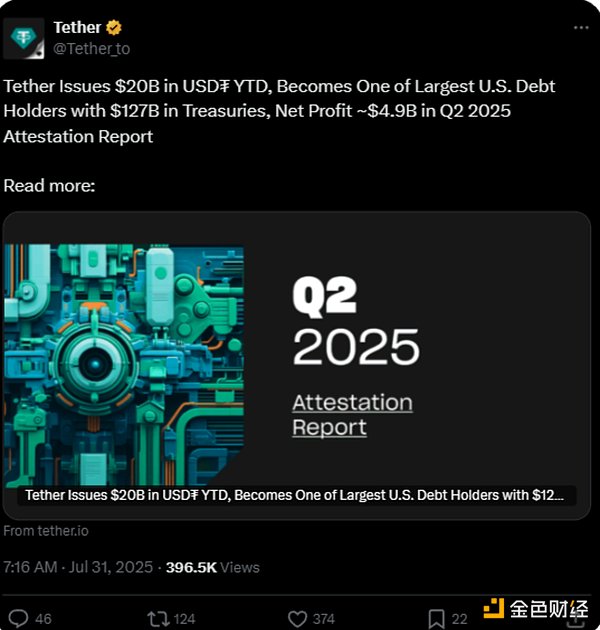Tether is striving to become one of the world's most valuable venture-stage companies, with its latest funding round reportedly valuing it on par with OpenAI. As the world's largest stablecoin issuer, responsible for securing over $170 billion in USDT reserves, Tether is now rumored to be seeking a jaw-dropping $500 billion valuation. If successful, this would mark a record-breaking valuation for the crypto industry and make Tether the most valuable company in the space! Today, we'll delve into Tether's massive funding round and explore how investors can justify such a sky-high valuation.
? The Age of Tether
According to a Bloomberg News report published last Wednesday, crypto stablecoin issuer Tether is seeking to raise $15 billion to $20 billion from private investors in exchange for approximately 3% of the company’s equity.
While the exact figures and terms of the deal remain unconfirmed, the funding round is said to value Tether at over $500 billion and will reportedly involve issuing new shares rather than providing liquidity for existing investors to sell their shares.
Shortly after the report was released, Tether CEO Paolo Ardoino confirmed the financing rumors on the X platform, noting that the capital injection is intended to support Tether's expansion in existing and new business lines by "several orders of magnitude" - including stablecoins, distribution and popularization, artificial intelligence, commodity trading, energy, communications and media. Just a few months ago, many crypto commentators were skeptical of USDC stablecoin issuer Circle’s seemingly aggressive $4 billion to $5 billion IPO target; yet the offering was ultimately 25 times oversubscribed, and CRCL stock easily soared to a valuation of over $20 billion on its listing day.
Now, Tether’s hypothetical $500 billion valuation would not only surpass leading crypto businesses like Coinbase and Circle, but would also make the company more valuable than any blockchain entity besides Bitcoin itself!
The Logic Behind the Valuation
Compared to Circle—Tether’s closest publicly traded competitor (currently valued at approximately $29 billion)—Tether has issued approximately 2.3 times as many stablecoins.
While at first glance this meager stablecoin multiple might seem unfavorable for Tether’s ambitious $500 billion fundraising, the devil is in the details when it comes to justifying this massive 17x valuation discrepancy. Unfortunately, because Tether does not publish a profit and loss statement as part of its quarterly reserve proofs, it's difficult to compare the two companies' financials. In the first six months of 2025, Circle's audited second-quarter financials show that its stablecoin reserves generated $1.2 billion in gross interest income. Adjusting this income for the circulating supply of USDT, we can estimate that Tether's reserve interest income was approximately $2.7 billion in the first six months of 2025. Assuming all variables (such as the circulating supply of stablecoins and interest rates) remain constant, this implies annualized core stablecoin reserve income of $2.4 billion for Circle and $5.5 billion for Tether, respectively. In addition to stablecoin reserve revenue, both Circle and Tether have other revenue streams. For Circle, other revenue primarily consists of subscription service contracts and gains (or losses) on digital asset holdings. These two items generated $50 million in the first six months of 2025, bringing Circle's total annualized revenue to approximately $2.5 billion. Tether lacks a profit and loss statement, making it impossible to accurately determine its operating income, but the stablecoin issuer reported $2.6 billion in gains from gold and Bitcoin holdings and $3.1 billion in "recurring profit" in the first six months of 2025. This brings Tether's annualized net profit to a whopping $11.4 billion.

Furthermore, crucially, Circle’s “Stablecoin Ecosystem Protocol” forces it to give nearly half of its USDC stablecoin reserve revenue to Coinbase, meaning that Tether earns twice as much per unit of stablecoin reserves as Circle.
Thus, using the comparable companies approach, we can multiply Circle’s current market cap ($29 billion) by a multiple of USDT supply (2.3), and then double that value (to account for Coinbase’s share of USDC revenue), to arrive at Tether’s estimated, already incredible, $133 billion valuation ($29 billion x 2.3 x 2).
While the rumored $500 billion valuation may be less based on fundamentals, it’s clear that this cash-rich issuer of tokenized dollars is operating on a completely different footing and at a much larger scale than its competitors. Tether enjoys significantly lower compliance costs than Circle and leverages regulatory arbitrage to pay low or no taxes, advantages that enable it to generate incredibly high profit margins at scale. CEO Paolo Ardoino even claims Tether's profit margins are as high as 99%. Furthermore, Ardoino emphasized that his company is just getting started, describing Tether as a "once-in-a-century company" with nearly unlimited potential to unlock new financial services and digital asset innovations. Conclusion While Tether's trillion-dollar valuation is easily supported by comparable data, justifying the leap to over $500 billion is significantly more difficult. At $500 billion, Tether would be the second most valuable "bank" in the world, more than double the value of Goldman Sachs and just behind JPMorgan Chase. Despite this, some Tether bulls are trying to make the figure appear reasonable. They argue that if U.S. Treasury Secretary Scott Bessent's recent predictions about stablecoin demand come true, interest rates remain high, and Tether maintains its dominance in the stablecoin space, then a $500 billion valuation could even be considered conservative. But for now, the final outcome depends on how the market reacts.
 Miyuki
Miyuki
 Miyuki
Miyuki Anais
Anais Anais
Anais Weatherly
Weatherly Alex
Alex Miyuki
Miyuki Weiliang
Weiliang Anais
Anais Alex
Alex Weatherly
Weatherly